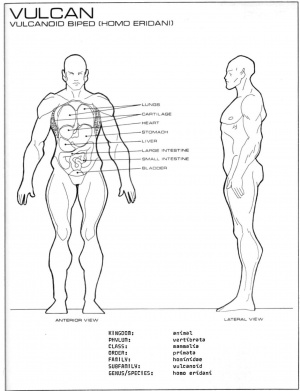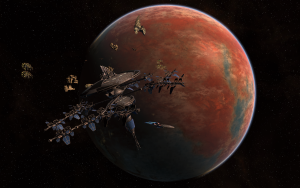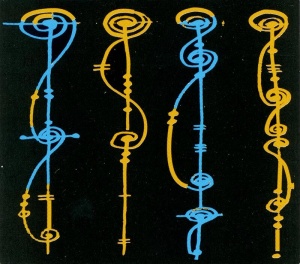Vulcan
From Star Trek: Theurgy Wiki
The Vulcans were a stoic, rational people. Widely claimed to be emotionless, in truth the Vulcans felt deeply and intensely, to their own detriment. Their stoicism came from a culture of logic and self-discipline, where emotions were analyzed and dissected to rob them of their potency so that they could not overwhelm or control the individual. Vulcans embraced science and reason, but their lives were not purely devoted to logic: they also had a deeply philosophical side, with art and music as vital to their culture as logic. They were also intensely private people, with many aspects of their culture — such as the rites of Pon Farr — which were not discussed amongst outsiders.
Psychology
Vulcans exalted logic over emotion and usually repressed or sublimated emotions in their daily behavior. Vulcans who dealt with non-Vulcans on a regular basis often maintained an almost glacial calm, possibly as self-defense against so much unguarded feeling. Among themselves, however, Vulcans usually seemed more relaxed; Vulcan ambassadors often cultivated a kind of distant good humor and politesse. Even Vulcan ambassadors, however, had trouble predicting or depending upon the behavior of more emotional species.
Physical Description
Vulcans closely resembled Humans, with the same average height and weight. Their pointed ears were slightly larger than the Human norm, and their slanted eyebrows sometimes gave them a questioning look. The inner, or nictitating, eyelid was not visible. Vulcan skin complexions ranged from olive to dark mahogany, with a green cast provided by their copper-based blood. The Vulcan heart rested in the lower center of the torso, surrounded and protected by highly efficient lungs.
Reproduction
The biological and anthropological origins of pon farr remained unclear, and Vulcan modesty defeated Vulcan curiosity, leaving the subject mostly unstudied. The secretion of a hormone complex known yamareen caused the pon farr, or mating cycle. Difficult to produce scientifically, all attempts to create yamareen in laboratory experiments were unsuccessful. In the prehistoric phase of Vulcan, men fought to the death regularly for the right to mate with females. This kept the population down (useful on a desert planet) and ensured that only the strongest survived to reproduce. It also hindered the growth of Vulcan society, as men would not cooperate with others who could soon be their deadly enemies.
Pon farr occurred every seven years, regardless of physical condition or the Vulcan's social capacity to mate. Those who felt the "blood stirring" did not always have the luxury of being ceremonially joined to another Vulcan. In this case, they were free to choose their mate as they saw fit, hoping that they would be accepted. If a Vulcan was rejected or if his pon farr is allowed to continue without mating, he was said to suffer from plak tow, the "blood fever."
Plak tow was extremely dangerous and could result in death if not carefully controlled. Those around a plak tow sufferer would not speak his name out of courtesy. Ideally, this was the Vulcan way of "ignoring" the incident's occurrence at all, allowing the sufferer to endure with a minimum of stigma from other Vulcans. This habit caused many deaths because a series of intense meditations and rigorous physical disciplines was required to survive an unrequited plak tow, and even those methods were not always successful.
Vulcans reverted to ancient mating ceremonies during their pon far, attempting to cover their emotional abandon with logic and ancient ritual. The parents of both parties, as well as representatives from the School of Surak or other religious orders, oversaw the mating contract. This ritual began well before puberty, to minimize irrational behavior and channel it toward social cohesion rather than the rutting madness that split Vulcan apart during its prehistory.
At age seven, Vulcans ceremonially bonded telepathically with their betrothed. This tradition dated back to the early, violent days of Vulcan history, when great families arranged marriages for convenience and alliance. Some families, notably those who were old, wealthy, or influential, held to this tradition, called koon-ul, "the joining." At the proper time, both individuals felt the strange rise of emotions, the nearly uncontrollable urges and overwhelming passions, signaling the star of pon farr. Other less traditional, Vulcans simply relied on shon-ha'lock, "the engulfment," to direct them to a mate at the proper time. This experience, although similar to human "love at first sight," was seen by most Vulcans as a dangerous but necessary experience, much like kahs-wan.
During pon farr, the two betrothed parties met at a ceremonial ground (usually the one belonging to the more influential family) and engaged in the rite of Koon-ut-kal-if-fee, "marriage or challenge." Here, the bride had the right to demand that the groom win her in mortal combat with a champion. (Some versions of the ritual allowed the bride herself to serve as her own champion in combat.)
Koon-ut-kal-if-fee was a survivor of ancient Vulcan customs from times when the great houses used marriages as tests of military and political strength. In modern times, a formalized question replaced this rite and the ceremony goes forth as planned. Koon-ut so'-lik, the formal marriage proposal, could occur during the koon-ul, at the beginnning of the mutual pon farr, or even at the conclusion of the ceremony. Althought much of the pon farr was public, the deep emotional nature of the situation caused Vulcans to shield it from the prying eyes of other races.
This was but one aspect of the Vulcan traditional reserve, stemming from a cultural fear of emotional vulnerability and exposure called k'oh-nar.
Homeworld
The planet Vulcan (or Ti-Valka'ain, in the Vulcan language) was the second plant of six orbiting the orange star 40 Eridani A (part of a trinary system; the other two stars were too far away to be immediately visible in Vulcan's sky). Vulcan was a harsh, desert world (barely a quarter of the surface area was water) with a thin atmosphere and high (1.4 G) gravity. Vulcan's geology produced starkly upthrust mountains: craggy, inhospitable, and inspiring to the planet's ascetic logicians and mystics alike. The capital city of Vulcan, ShirKahr, was a low, stark city laid out in logical grids and quarters around an ancient oasis.
Vulcan Ecology
Temperature and Climate
Flora and Fauna of Vulcan
Geography
Culture
Art
Architecture
Cuisine
Religion
The Twilight of the Gods
The Inner Chorus
T'plana-Hath and the Birth of Vulcan Logic
The School of Surak
The Way of Jarok
The School of Nirak
The One Mind School
The Kolinahr Path
The Hakihr Way
Katra: The Vulcan Soul
History
The Age of Antiquity
The Time of Awakening
Rift with the Proto-Romulans
The Golden Age
The Romulan War
To the Stars
First Contact with Humanity
The Federation
Government
The Vulcan Council
Elections and Impeachment
Council Functions
The Ministry of State
The Ministry of Defense
The Ministry of Security
The Ministry of Health
The Ministry of Thought
The Ministry of Science
The Ministry of Trade
Vulcan Diplomacy
The Vulcan Isolationist Movement
Language and Names
Vulcan and Federation Standard was the dominant language spoken by Vulcans.
Vulcans used only given names, though in ritual greetings they added their parent's name (and sometimes more), as in Spock, son of Sarek, son of Solkar. Even Vulcans of extremely ancient and powerful families used no honorifics; aristocracy was illogical, and logically, anyone worth impressing should already know who you were without being reminded of your family's status.
Male Names
Delvok, Kov, Lojal, Sakar, Sakkath, Sanshiin, Sarek, Satelk, Satok, Savar, Skon, Solkar, Solok, Sonak, Sopek, Soral, Soval, Spock, Stonn, Surak, Sybok, Tavin, Tolaris, Tuvok, Vanik, Vorik
Female Names
Saavik, Sakonna, Selar, Senva, Sitak, T'Lar, T'Lara, T'Pan, T'Para, T'Pau, T'Pel, T'Penna, T'Pera, T'Plana-hath, T'Pol, T'Pring, T'Shanik, Tallera, V'Lar, Valeris
Species Abilitis
Reference works used in creation of this page
Information & images found on this page have been compiled from many sources on the Internet.
1. http://en.wikipedia.org/wiki/Star_Trek
2. http://memory-alpha.org/en/wiki/Vulcans
3. http://www.vulcanlanguage.com/
4. http://www.ditl.org/
5. http://www.ex-astris-scientia.org/history.htm
6. http://www.geocities.com/shirkahr/VulcanTimeline.html
7. http://www.ccdump.org/
8. http://www.starbase118.net/wiki/index.php/Vulcan_(planet):_The_Provinces_of_Na’nam
9. http://www.geocities.com/shirkahr/ShirKahrCity.html
10. http://www.projectrho.com/vulsun.htm
11. “The Way of Kolinahr” by Last Unicorn Games
12. “Sarek” by A.C Crispin
13. “The IDIC Epidemic” by Jean Lorrah
14. “Spock’s World” by Diane Duane




